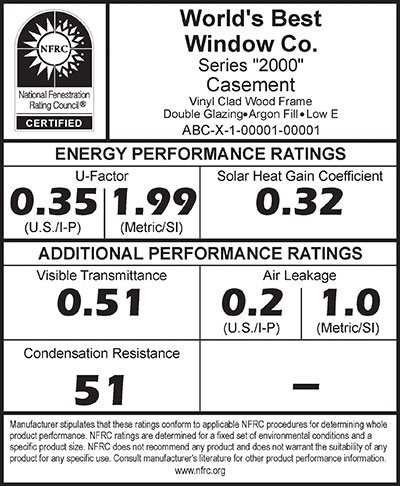
Articles
Codes & Standards
A trusted label
October 30, 2013 By Ray McGowan NFRC senior program manager
 Assessing windows for energy efficiency is a new thing for most building inspectors. Easily recognizable NFRC labels will help prevent confusion and delays.
Assessing windows for energy efficiency is a new thing for most building inspectors. Easily recognizable NFRC labels will help prevent confusion and delays. As provinces update their building energy codes or adopt other energy-saving legislation, it is becoming more important than ever for manufacturers to demonstrate the energy performance ratings of their windows, doors, skylights, and other fenestration products. Even though energy codes for fenestration vary by province, manufacturers can use the National Fenestration Rating Council’s independent energy performance ratings to show that their products perform as advertised.
As provinces update their building energy codes or adopt other energy-saving legislation, it is becoming more important than ever for manufacturers to demonstrate the energy performance ratings of their windows, doors, skylights, and other fenestration products. Even though energy codes for fenestration vary by province, manufacturers can use the National Fenestration Rating Council’s independent energy performance ratings to show that their products perform as advertised.
In January 2014, the Ontario Green Energy Act’s energy performance certification requirements for residential windows will go into effect. While some exemptions to the requirement exist (see the Green Energy Act for details), manufacturers who sell windows in the province will need to rate and label most residential windows using NFRC 100/200 or CSA A440.2. Ontario already requires Supplementary Standard SB-12: Energy Efficiency For Housing. In SB-12, NFRC ratings are required to satisfy the prescriptive requirements of this energy code.
A trusted source of energy ratings since 1989
Industry leaders formally discussed the NFRC concept at an ASHRAE meeting in Vancouver in 1989, and soon after, with help from the U.S. Department of Energy, founded NFRC in the United States to serve as a non-profit, third-party organization to rate and label fenestration energy performance. Today, NFRC has an international reach with licensees and participating manufacturers worldwide.
Canadian consumers, architects and builders rely on NFRC ratings to compare product performance, specify products, and demonstrate energy code compliance, while window manufacturers certify products through NFRC so they are eligible for the Energy Star program for residential windows. Code officials rely on NFRC’s certified ratings to confirm building energy codes for fenestration are met.
NFRC’s residential label and commercial label certificates used in the United States are the same as those in Canada, except that labels/label certificates in Canada use both the English and French languages and the U-factor and Air Leakage ratings are provided in imperial and metric units. Solar Heat Gain Coefficient and Visible Transmittance are dimensionless indices varying from 0 to 1.0.
NFRC provides the procedures more than 750 residential manufacturers use to rate and label nearly 8,000 product lines and more than nine million fenestration product options. In Canada, NFRC labelling and rating involves computer simulations and physical tests. NFRC has rated over 250 commercial projects in the United States and Canada, compiled over 15,000 frame, spacer, and glazing components into its commercial software databases, and licensed 10 accredited laboratories in the United States and Canada who provide these commercial NFRC ratings.
The certification process
Residential manufacturers must go through a series of well-defined steps to certify a product. First, a window manufacturer sends product drawings and specifications to an NFRC-accredited simulation laboratory that uses energy simulation software to calculate energy ratings. The manufacturer then selects a product and ships it to an NFRC-accredited testing lab for physical testing. If the ratings from the physical test are within the required tolerance of those from the computer simulation, NFRC considers the ratings valid.
The simulation and testing labs send their results to one of four NFRC-accredited inspection agencies for review. The IA confirms the simulation and physical testing comply with NFRC procedures. The IA inspects each manufacturing facility once a year to make sure the products submitted for testing are the same as those being produced and all NFRC procedures are being followed.
NFRC uses a different process for non-residential or commercial windows, curtainwalls, doors and other fenestration assembled on the project site. NFRC’s Component Modeling Approach uses ratings for pre-approved components (frames, glazing, and spacers) to generate whole-product performance values. CMA’s software tool, known as CMAST, generates ratings, which can be certified for code compliance. Unlike the residential program, where manufacturers attach a temporary NFRC label to a window, the CMA program issues a Label Certificate, a multi-page document listing ratings for all NFRC-certified fenestration to be used in a specific building or project. In addition, commercial manufacturers’ rated components may be used over and over on numerous projects, greatly reducing the testing requirements present in the residential program. CMA ratings are project-based, enabling code officials to review fenestration ratings for an entire project on a single Label Certificate. Label Certificates are posted on NFRC’s public website and may be downloaded at no charge at any time.
NFRC’s commercial and residential programs use the same ISO15099-based procedures to rate and certify the energy performance of fenestration fairly and accurately, which manufacturers have trusted since 1989. To learn more about NFRC, please visit.
Ray McGowan is NFRC’s senior program manager. He also serves as the vice-chair of ASHRAE’s Fenestration Technical Committee (TC 4.5) and the chair of its Research Subcommittee, and is a member of SSPC 90.1/Envelope Subcommittee.
Print this page
Leave a Reply